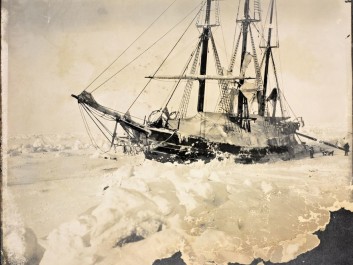This Month in Astronomical History: April 2020
Thomas Hockey University of Northern Iowa
 Each month as part of this series from the AAS Historical Astronomy Division (HAD), an important discovery or memorable event in the history of astronomy will be highlighted. This month's guest author, Thomas Hockey, recounts one of the strangest solar eclipse expeditions in history. Interested in writing a short (500-word) column? Instructions along with previous history columns are available on the HAD webpage.
Each month as part of this series from the AAS Historical Astronomy Division (HAD), an important discovery or memorable event in the history of astronomy will be highlighted. This month's guest author, Thomas Hockey, recounts one of the strangest solar eclipse expeditions in history. Interested in writing a short (500-word) column? Instructions along with previous history columns are available on the HAD webpage.
The “Remarkable” Eclipse of 1894
April marks the anniversary of one of the strangest eclipse expeditions ever launched. A solar eclipse was witnessed from near the North Pole — nine years before the invention of the airplane. It was the plan of neurologist-turned-arctic-explorer Fridtjof Nansen (1861–1930) to reach the yet unseen pole in a novel way: He would intentionally entrap a vessel within the winter’s frozen Arctic Ocean and let the presumed icepack drift carry him to his destination. Nansen and his crew of 12 set out in 1893 on the Fram, a vessel designed to “pop out” of the sea ice instead of being crushed by it. They were still well short of the pole by April of the following year when a rare hybrid eclipse was visible from their location. (Such an eclipse is total along part of its path, annular along the rest.) Of the eclipse, Nansen wrote:
“Friday April 6th. A remarkable event was to take place to-day which, naturally, we all looked forward to with lively interest. It was [a deep partial] eclipse of the sun.... It was important for us to be able to get a good observation, as we should thus be able to regulate our chronometers to a nicety. In order to make everything sure, we set up our instruments a couple of hours beforehand, and commenced to observe. We used the large telescope and our large theodolite. [Sigurd Scott] Hansen, [Frederick Hjalmar] Johansen, and myself took it by turns to sit for five minutes each at the instrument, watching the rim of the sun, as we expected a shadow would become visible on its lower western edge, while another stood by with the watch. We remained thus [a] full two hours without anything occurring. The exciting moment was now at hand....Hansen was sitting by the large telescope when he thought he could discern a quivering in the sun’s rim; 33 seconds afterwards he cried out, ‘Now!’ as did Johansen simultaneously.... A dark body advanced over the border of the sun 7½ seconds later than we had calculated on. It was an immense satisfaction for us all...for it proved our chronometers to be in excellent order. Little by little the sunlight sensibly faded away, while we went below to dinner. At 2 o’clock the eclipse was at its height, and we could notice even down in the saloon how the daylight had diminished. After dinner we observed the moment when the eclipse ended, and the moon’s dark disk cleared the rim of the sun.”
Imagine standing outside for hours on an arctic April’s day. And, yes, Nansen and the others did choose to eat lunch during maximum eclipse! But, of course, their primary mission was not to observe the eclipse, but to reach the North Pole. However, Nansen’s hypothesized icepack current proved too slow and erratic. At the time of the eclipse, the voyagers’ latitude was only about 80° N.
On 14 March 1895, with their ship icebound some 7° (nearly 500 miles) from the North Pole, Nansen and Johansen took off by themselves on dog sled. They got a few degrees farther north, but as food began to run out, turned for Franz Josef Land. Fifteen months after leaving the Fram, they were rescued by British explorer Frederick Jackson in one of the most fortuitous polar meet-ups of all time. The Fram, freed from the ice, finally made it to Spitsbergen Island, Norway, in late 1896. Although Nansen and Johansen did not reach the pole, their maximum coordinate, 86° 14’ N, represented the most northerly documented latitude attained by any adventurer at the time, and their ship’s journey among the most unusual eclipse “expeditions” ever conducted.


References
1. Nansen, F. 1897, Farthest North: Being the Record of a Voyage of Exploration of the Ship “Fram” 1893-96 and of a Fifteen Month Sleigh Journey by Dr. Nansen and Lieut. Johansen (New York: Harper and Brothers).
2. Potemra, Thomas A. 1991, “The Arctic Explorations of Fridtjof Nansen,” Johns Hopkins APL Technical Digest, 12, 275. https://www.jhuapl.edu/Content/techdigest/pdf/V12-N03/12-03-Potemra.pdf
3. Bazilchuk, Nancy. 2013, “Frozen in the Ice – Polar Research Then and Now,” Science Norway. https://sciencenorway.no/arctic-forskningno-fridtjof-nansen/frozen-in-the-ice---polar-research-then-and-now/1387372

